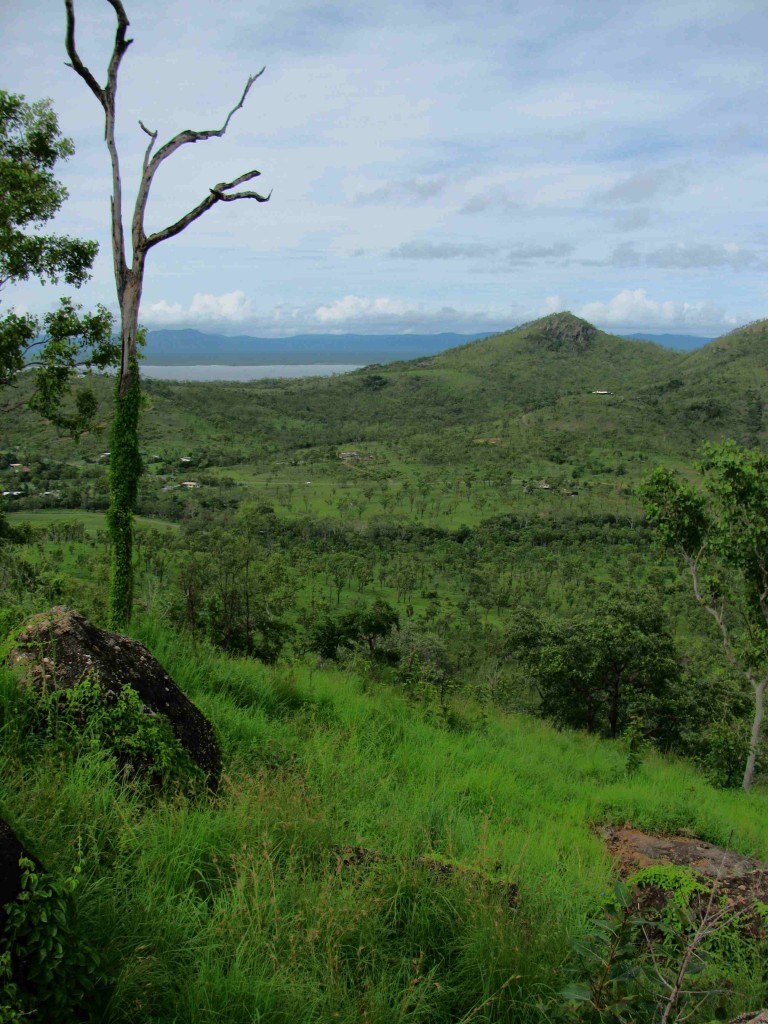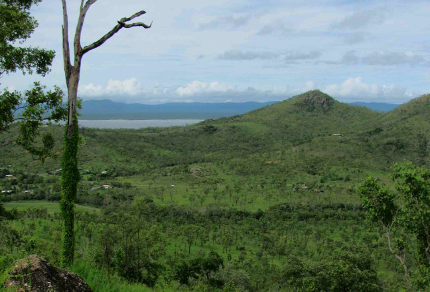The ambience of Townsville at 6:10 a.m. struck me as being muted – the muted “doodle-doos” of peaceful doves tucked against the receding night, the muted air still and thick with humidity, the muted city street noises far beyond the golf course’s quiet border. As I and an unusual number of other runners pushed through the sticky air blanketing the Ross River Parkway, other influences clanged against the softened city ambience – a garbage disposal truck clanking while performing its start/stop duty of emptying Rosslea’s refuse, the fussing squawks of rainbow lorikeets etching audio scratches on the chalkboard of the morning air, a motorboat growling as it frothed its way upstream on the river as far as Aplins Weir. Magpie-larks swirled and circled in the air, calling out in clear, ringing tones like an avian bell choir possessing only small, high-pitched bells. Terns ripped the air with burring screams and skimmed over the waterway with all the smooth elegance of a bird whose seasonal migrations carry it from the far south of the Southern Hemisphere to the far north of the Northern Hemisphere and then back again.

Oak Valley near Townsville, Queensland (© Vilis Nams)
On my return to the house, I researched red-bellied black snakes, one of which I think high-tailed it away from me yesterday morning in the Oak Valley Reserve. I learned that this species is one of eastern Australia’s most well-known and beautiful snakes.1 Red-bellied blacks are characterized by a solid, shiny black dorsal surface and red to creamy belly, and grow to 2 metres in length.1 Generally found in wet areas near rivers or swamps, the red-bellied blacks are frog hunters par excellance, but will consume small mammals and reptiles, and even eels and other fish on occasion.1,2,3,6 Their dietary preference for frogs puts them at risk for being poisoned from eating cane toads, and populations of these snakes have shown a pronounced decrease since the introduction of the cane toad.1,3
I watched a You Tube video of two male red-bellied black snakes engaged in combat during mating season,4 which is in spring.1 With bodies entwined, the snakes slithered through the videographer’s camp, all the while shoving and slamming each other with their heads and upper bodies, which were held up off the ground.4 Scientific observations have shown that such combat sessions last 2 to 30 minutes, and that male red-bellied blacks may attack and bite rival males mating with a female.5 It seems that for male red-bellied blacks, procreation can be a fight all the way. Females of this species give birth to up to 40 live young, each enclosed in a membranous sac, which is the egg membrane.1,3 The young break out of their sacs within minutes and are on their own in a world where predators of tiny snakes – including adult red-bellied black snakes – abound.2,3 The result is that only a few young survive to adulthood.3
With a morbid sort of fascination, I also read that the classic symptoms of being bitten by a red-bellied black snake include pain, headache, dizziness, and vomiting, while signs include inflammation and tissue death at the bite site, and sometimes collapse or convulsions.6 Thankfully, red-bellied black snakes are not aggressive2 and, as I observed yesterday, usually retreat from confrontation. Before arriving in Australia, I boned up on first aid for dangerously venomous snake bites. Treatment doesn’t include cutting the bite-site and sucking out the poison like in old western movies, or the use of tourniquets. Rather, the bitten limb (it’s usually a limb) is immobilized by wrapping it snugly and splinting it or putting it in a sling.7 This is called pressure immobilization, and is followed by getting the victim to a hospital as fast as possible so that antivenom can be administered.7 With Australia’s excellent medical facilities, an average of fewer than 3 people die each year from snake bites.8
Sunshine poured down on Townsville all day, making me content to work indoors until late afternoon, when I escaped my laptop and returned to the here and now. Vilis and I cycled to the fitness park, past the flooded river that somehow surprised me with its rich green meadows spread below the towering cliff faces of Mount Stuart. A large flock of Australian white ibises waded in the flooded meadows, their presence seeming incongruent with that of Annandale’s modern houses visible on the far side of the river. “They look like they belong somewhere else,” Vilis remarked. “Somewhere exotic, like Africa.” Then he laughed. “Or Australia.”
References:
1. Steve Wilson and Gerry Swan. A Complete Guide to Reptiles of Australia. 2008. New Holland Publishers (Australia) Pty Ltd, Sydney, p. 458.
2.Australia Zoo. Amazing Animals: Red-bellied Black Snake. © Australia Zoo. Accessed 21-Feb-2010. http://www.australiazoo.com.au/our-animals/amazing-animals/reptiles/?reptile=venomous_snakes&animal=red-bellied_black_snake
3. Wikipedia. Red-bellied black snake. Updated 10-Nov-2010. Accessed 23-Nov-2010. http://en.wikipedia.org/wiki/Red-bellied_Black_Snake
4. YouTube. Red belly black snakes fight through camp. Uploaded by fieldmor77. Accessed 22-Feb-2010. http://www.youtube.com/watch?v=CsZ6mYkd_4M
5. Richard Shine, Gordon C. Grigg, Terri G. Shine and Peter Harlow. Mating and Male Combat in Australian Blacksnakes, Pseudechis porphyriacus. 1981. Journal of Herpetology 15(1): 101-107. © 1981 Society for the Study of Amphibians and Reptiles. Accessed 22-Feb-2010. http://www.jstor.org/pss/1563652
6. The University of Adelaide Clinical Toxicology Resources. Pseudelchis porphyriacus. © Toxicology WCH. Accessed 23-Nov-2010. http://www.toxinology.com/fusebox.cfm?fuseaction=main.snakes.display&id=SN0525
7. Queensland Government, Queensland Health. Pressure Imobilisation Technique. Updated 27-Jun-2007. Accessed Nov-2009. http://www.health.qld.gov.au/poisonsinformationcentre/bites_stings/bs_pressure.asp
8. The University of Melbourne. Snakebite Mortality in Australia. Accessed 23-Nov-2010. http://www.nchirt.qut.edu.au/consultancy/amdig/workshops/documents/2003WinkelSlides.pdf


